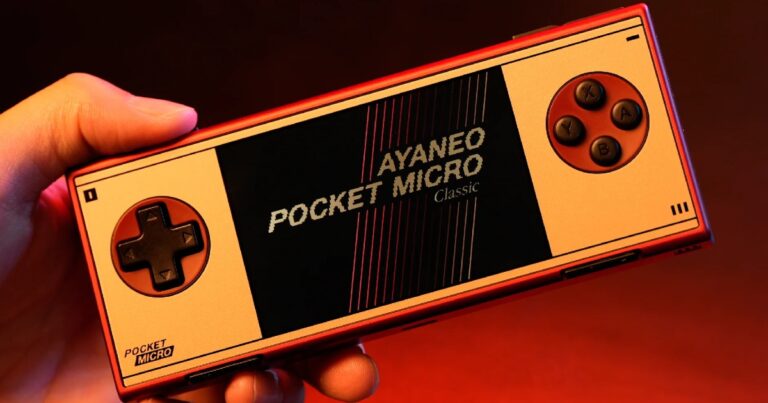The AYANEO Pocket Micro Classic is proof that good things come in small packages, plus thoughts on Look Outside and Indiana Jones on PS5.
When I first got my hands on an AYANEO device with the AYANEO Air, the tech company was still pretty fresh in the portable handheld market. A number of years have passed since that moment and in that time the company has tried to keep up with the insanely heated competition with an absolute flurry of devices. Its latest unit is the AYANEO Pocket Micro Classic, and if you’ve been searching for a tiny powerhouse to replay your GBA collection you’re going to be one happy camper indeed.
First things first: while the naming convention is admittedly a little confusing, this is not the same unit as the AYANEO Pocket Micro which was only released at the start of this year. Instead, this Classic model ditches the analogue sticks at the bottom of the unit to be more visually in line with the console’s obvious inspiration – the Game Boy Micro. This switch-up in design does two things. The first is that it shifts both the D-Pad and face buttons to the middle of the AYANEO Pocket Micro Classic’s shell, making it slightly more comfortable to play with when compared to the initial model. The monkey’s paw to this is that modern systems which default to analogue control have now become more difficult to emulate.
Aesthetically though, the AYANEO Pocket Micro Classic is a nice-looking system. Available in a range of colours, I spent my time with the Magic Black model and it’s a sleek looking bit of kit, even though it does become a bit of a fingerprint magnet – amplified by the unit’s touch controls. Still, the Game Boy Micro adoration is clearly on display here, but that does mean the solid rectangular design is retained, which while authentic, is hardly the most ergonomic choice around and does mean your hands may start to cramp after lengthy gaming sessions. Still, I really liked the aluminium alloy frame which gives the unit real weight and a premium feel in the hands, differing from much of the plastic-focused competition.
Speaking of differences, it’s also worth noting that the AYANEO Pocket Micro Classic differs from many of the company’s own offerings by implementing Android 13 as its main operating system. There’s both positives and negatives to the move. The clear benefit is that without having to licence Windows, it helps keep the Pocket Micro’s cost down. This unit will set you around $350 which is by no means cheap, but for me is perfectly reasonable considering the premium build quality, and when compared to AYANEO’s other Windows-based options that can go as high as $1700 (though those machines are obviously much beefier siblings).
The downside is that by embracing Android you do lose some of the finer flexibility for those who like to dig into the weeds and tinker with Windows-based settings, however having access to the Android Play Store can actually make emulation an easier process for newcomers, with a whole suite of popular offerings already accounted for, without having to fuss about web searches and install packages.
Love Film & TV?
Get your daily dose of everything happening in music, film and TV in Australia and abroad.
As a result, actually using the device has been pretty simple. Thanks to the Android Play Store I managed to get up and running with multiple systems and games in under 10 minutes and was surprised at how powerful it was despite the smaller formfactor. NES, SNES and GBA games were always going to run perfectly fine on the AyaNEO Pocket Micro Classic with zero slowdown. They also look positively stunning thanks to the 960×640 3.5-inch IPS screen that despite not being OLED still shines brightly thanks to its ability to boost the GBA’s original resolution by 4. Plus, the choice to go for a 3:2 screen ratio means you won’t run into any pesky black bars. This is all to say that if you’re in the market to replay your GBA collection in one of the most authentic ways, this is absolutely it.
Start working your way up towards N64, GameCube and Dreamcast on the other hand, and you’re in for a rougher time. It’s not that the unit lacks grunt. In fact, thanks to the MediaTek Helio G99 SoC within the Pocket Micro I was able to get a handful of GameCube and PS2 titles up and running, but due to the lack of analogue sticks when compared to the original Pocket Micro, the experience with the Pocket Micro Classic simply isn’t as comfortable or practical. Yes it’s possible to map some of these controls to the D-Pad instead, but it’s far from ideal and not great for every game.
I should also note that if you want to fine tune your experience and stray away from the Android operating system you can always install popular front ends like Emulation Station for a prettier experience.
The AYANEO Pocket Micro Classic is not going to be for everybody. If you simply want to play GBA games without any of the pricey overheads, well then investing in this device might be overkill. But if you’re a hardcore retro gamer who wants to replay their GBA collection with one of the most premium devices on the market, the AYANEO Pocket Micro Classic excels, is a delight to use and is highly recommended.
The AYANEO Pocket Micro Classic is available now via the AYANEO store.
Also out now…
Indiana Jones and the Great Circle (PS5)
I was already a fan of Indian Jones and the Golden circle when it first released last year, and this PS5 edition just opened the doors for a whole new range of PlayStation gamers. By and large this port is the exact same as it’s xbox counterpart, but there are a number of fancy bells and whistles that make use of the new hardware.
Case in point: both adaptive triggers and haptic feedback are both accounted for and help add extra realism to hand-to hand combat and gunplay for those who don’t find the effects too distracting. Likewise, the touchpad lights now show when you’re in stealth or under threat, but the real shine comes via the PlayStation 5 Pro. Be invested in Sony’s premiere console and you’ll be treated to native 4k resoktuon while still being able to manage advanced raytracing.
It’s the best way to play the game on console bar none.
Look Outside (PC)
Devolcer digital has been cultivating a reputation for showcasing quirky games with serious style and Look Outside has that in spades.
It all starts when a mysterious event turns anybody who looks out their window into some sort of horrific being. As luck would have it though, you had your curtains drawn, leaving you in the middle of an absolute frewkfast as you navigate your apartment building just trying to survive. But this horror RPG is far from simple. Depending on your difficulty resources are scarce and around every corner is more paranoia.
Creatures that defy general description are aplenty and an unwanted knock at your door is all too common, leaving you to decide who to trust (if anybody at all).
Coupled with a delivery dark pixel art style, Look Outside can have fun with its horror setting by not feeling tied to any sense of realism.
For more on this topic, follow the Gaming Observer.

































